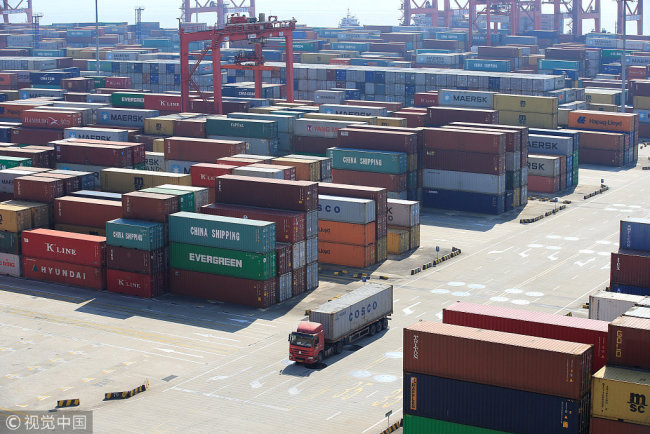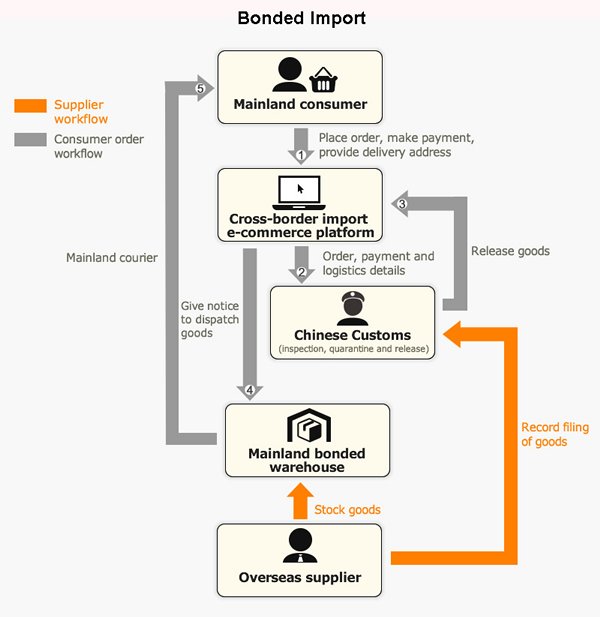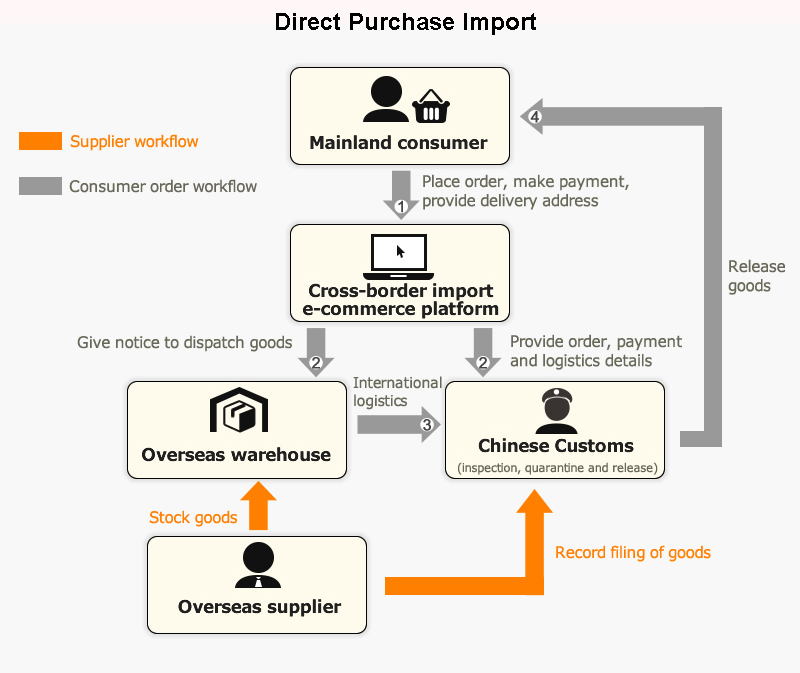Perfecting Your Logistics Solution for Cross-Border E-Commerce in China
The previous chapters within this guide are necessary steps the brands must consider and prepare before moving forward to the logistic aspect of cross-border e-commerce. If you review the previous chapter on regulations and policies, China have their own set of unique regulations and charges for all imported goods.
Review of Importing System
There are two importing model businesses can utilize when undergoing cross-border e-commerce in China: Direct and Bonded.

Bonded imports have two models, bonded warehouse and direct mailing. Both bonded import model first collects all information from the consumer and later delivered to the warehouse for shipment. The difference between bonded warehouse and direct mailing is the location of the warehouse. Bonded warehouse model has warehouses located in China where products are cleared through custom prior to shipment, whereas direct mailing have warehouses located in a distribution centered linked with Chinese customs oversea.
Bonded Import B2B2C
The popularity of cross-border e-commerce begun with Daigou, who purchase goods oversea and ship to consumers in China using public courier services. Since then, there have been a huge number of semi-legal shipments incoming to China, even B2B. The government of China have established Free Trade Zones/Pilot Zone in late 2013 for regulated and supervised cross-border e-commerce. These pilot zones are designated for bonded warehouses with e-commerce purposes. There exist 13 pilot zones all across the regions of China.

List of regions with pilot zones:
- Shanghai
- Hangzhou
- Ningbo
- Zhengzhou
- Chongqing
- Guangzhou
- Shenzhen
- Tianjin
- Hefei
- Chengdu
- Dalian
- Qingdao
- Suzhou

Bonded warehouse offers several advantages to cross border e-commerce businesses. To name them, bonded warehouse offers a shorter distance between the product and consumer, thus shorter delivery time for higher customer satisfaction. Businesses using bonded warehouse can easily transport revenue to foreign bank account, and no local business entity is necessary. This logistic solution is suitable for brands testing new products by stocking a small to medium batch in a bonded warehouse to avoid high risk of losses due to high investment in stocks.
Direct Import B2C
Purchases from consumers follow procedure to directly transport goods from oversea warehouse/storage using a courier system as private or personal package to China. Shipping payments are often paid by the consumers themselves or included based on the policies of the business, duty fees may also apply to consumers when receiving packages. Many Chinese consumers are acceptable to this import model as the item is directly shipped from oversea as it seems more trustworthy. There are three different solution for this model to deliver goods to Chinese consumers

Postal mailing was the most frequent method used to send parcels before the introduction of bonded warehouses for oversea businesses. The parcel is often clear by China Post or EMS where restrictions tend to be more lenient as it is treated as an personal package.
Commercial mailing is similar to bonded import as it requires a bonded warehouse for clearance to be rightfully processed, however, the parcel is previously packaged, labelled oversea with the information pre-completed before arriving at the bonded warehouse. Lastly, after the clearance is completed, delivery is accomplished by local shipment companies.
Personal express share both aspects of commercial and postal, it follows the restrictions of postal policies while requiring product, shipment and payment information, as well as consumer ID, which makes this solution to be tedious for consumers and business to do cross-border e-commerce.
General Trade Imports
The general trade import model follows the B2B2C model where goods are imported in China, in bulk shipments, to be processed under clearance and later sold on local e-commerce platforms. Storage and warehousing will not require a bonded warehouse, all revenue will be received on a local Chinese bank account. However, this solution is much more suitable for developed and well-established brands who have high turn-over rate for goods doing both offline and online sales with local oversea goods curating platforms.
Fast Moving Consuming Goods (FMCG)
Food is a necessity for survival and one of the major imported and exported goods for all countries. To greatly serve a population of over 1.3 billion population, there is a high number of imported goods from foreign countries, such as fruits, vegetables, meat, dairy and more. Fruits are one of the produces in high demands, there are specialty fruits from foreign countries well-loved in China as it is not natively accessible. There are far more challenges and differences between produces to goods such as clothing for cross-border e-commerce. FMCG are far more susceptible to risks of quality control, efficiency, and regulations.

FMCG have short shelf life and are easily perished, thus, there is a degree of freshness that must be maintained for consumers, such as meat, milk and vegetables. Firstly, there are unique regulations to fresh produces, these produces must fall under the positive list for cross-border e-commerce in China and originating country. Secondly, the difference between chilled and frozen produces must be clearly identified for the best logistic solution. Chilled food is averagely fresher than frozen food, thus, these produces are handled with higher priority, as well as a higher price tag to consumers. Frozen food on the other hand perish slower than chilled food, making it lower on the priority list. Lastly, one of the risks that FMCG business can run into for cross-border e-commerce is the risk of non-accepted delivery, which often result in loss of margin as it is return to non-cooled distribution.
In the past recent years, JD and Yi Jiangnan have partnered with Guangzhou Baiyun Airport to establish a cross-border free trade zone with a bonded cold-chain warehouse to provide a more sophisticated system to FMCG businesses by direct sourcing, in which reduces costs for purchases, logistics and storage. Consumers and business can receive imported FMCG as fast as within four days.

To simplify, the two model for cross-border e-commerce FMCG are direct sourcing and procurement. Direct sourcing is the direct delivery of FMCG from the business to the e-consumers, however, the procurement model is also frequently popular among cross-border e-commerce businesses. As the procurement partner will handle the entire procedure with a developed procedural system of sales, logistics, warehousing and customer services.
Local Delivery Service Providers To Consider
To successfully establish a developed logistic system for your business, we have a list of local delivery service providers you and your business can look into for more logistic information.
- SF Express
- EMS
- Yuan Tong
- STO Express
- Yunda Express
- Best Express
- ZTO Express
- Zhai Ji Express
- Tuantian Delivery
- EMS E-Express
- FedEx
- DHL


 A Complete Guide to Cross-border E-commerce in China
A Complete Guide to Cross-border E-commerce in China


